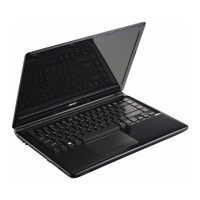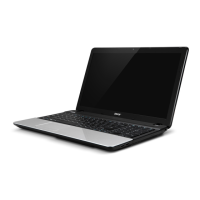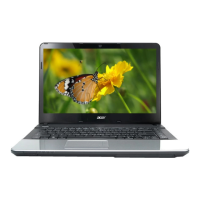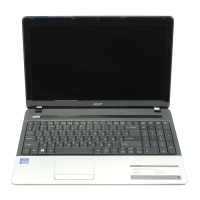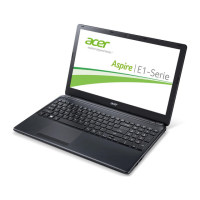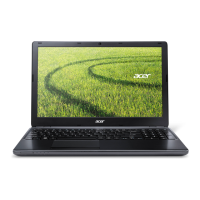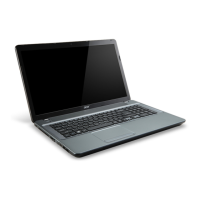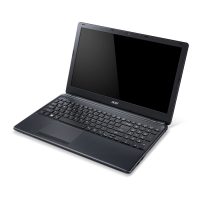Do you have a question about the Acer Aspire E1-470 and is the answer not in the manual?
Covers general safety, power cord access, grounding, and electrical power usage guidelines.
Warnings and instructions to prevent hearing loss from prolonged headphone use at high volumes.
Precautions for handling, ventilation, avoiding liquids, vibration, and extreme temperatures.
Advice on professional servicing and guidelines for safe Lithium-ion battery usage.
Process for conditioning new batteries, factors affecting lifespan, and temperature guidelines.
Information on RF interference and safety for medical devices, vehicles, and explosive environments.
Guidance on electronic waste disposal, mercury advisories, and Energy Star compliance.
Tips for comfortable computer usage, including posture, vision care, and developing good work habits.
Overview of documentation provided to help users get started with their Acer notebook.
Essential tips for daily computer care, including power, AC adapter, battery, and cleaning.
Identifies and describes the webcam, screen, and microphone on the notebook.
Explains system indicators, SD card reader, and USB port types.
Identifies the power button, keyboard, touchpad, and click buttons on the notebook.
Details the ports located on the left side of the notebook, including security and display connections.
Describes the ports and optical drive components found on the right side of the notebook.
Identifies components on the notebook's base, including battery bay, memory, speakers, and cooling fan.
Explains the function of Windows-specific keys like the Windows key and Application key.
Details the operation of lock keys (Caps Lock, Scroll Lock) and the embedded numeric keypad.
Lists and explains function key (Fn) combinations for controlling system features.
Explains fundamental touchpad operations like cursor movement and clicking.
Describes advanced touchpad gestures such as swiping and pinching for enhanced control.
Step-by-step guide on creating a full system recovery backup onto a USB drive.
Instructions for creating a backup of essential drivers and pre-installed applications.
Details methods for system recovery, including reinstalling software and factory resets.
Procedures for reinstalling pre-installed drivers and applications using the system or backup media.
Guide on using Microsoft System Restore to revert the system to a previous state.
Explains how to restore the computer to its original factory settings using built-in recovery or backups.
Information on managing power settings, including disabling fast startup and configuring power button actions.
Details battery characteristics, charging procedures, and the initial conditioning process for new batteries.
Provides recommendations for maximizing battery operational time and lifespan through proper usage.
Explains how to check the current battery level and what to do when a low battery warning appears.
Step-by-step instructions for safely installing and removing the notebook's battery pack.
Steps for disconnecting external accessories and tips for moving the computer over short distances.
Guidance on preparing the computer for travel, including packing and essentials for meetings.
Advice for international travel, including power compatibility and documentation requirements.
Instructions for using a physical security lock to protect the computer from theft.
Details on setting and using Supervisor, User, and Boot passwords for system security.
Explains how to connect the computer to a wired network using the Ethernet port.
Steps for connecting to available wireless networks and the internet.
Describes wireless LAN technology, its benefits, and essential components like access points (routers).
Explains the High-Definition Multimedia Interface (HDMI) and its use for audio/video connections.
Details the function of the Universal Serial Bus (USB) port for connecting peripherals.
Instructions on how to play DVD movies and information about region codes.
Information on accessing and using the BIOS utility for hardware configuration.
Guide on configuring the boot sequence and setting BIOS passwords for security.
Solutions for common problems like power, display, audio, keyboard, and printer malfunctions.
Explains Windows 8 interface elements like Start screen, Charms, app management, and personalization.
Guidance on checking for Windows updates and finding additional product information.
Information on requesting service, international warranty, and necessary details for support calls.
Details regulatory compliance statements for FCC, Canada, EU, and various national codes.
Safety notices regarding RF exposure, LCD pixels, peripheral devices, and Canadian RF regulations.
Information on restricted wireless frequency bands and power limitations in specific regions like France.
| Graphics | Intel HD Graphics 4000 |
|---|---|
| Weight | 2.1 kg (4.63 lbs) |
| Processor | Intel Core i3-3217U |
| RAM | Up to 8GB DDR3 |
| Storage | 500GB HDD |
| Display | 14 inch, 1366 x 768 pixels |
| Operating System | Windows 8 |
| Battery | 4-cell Li-ion |
| CPU Options | Intel Core i3-3217U |
| Optical Drive | DVD-Super Multi DL drive |
| Wireless | 802.11b/g/n |
| Ethernet | 10/100/1000 Mbps |
| Ports | 2x USB 2.0, 1x USB 3.0, HDMI, VGA |
| Dimensions | 342 x 245 x 25.3 mm |
| Webcam | HD webcam (1280x720 resolution) |
